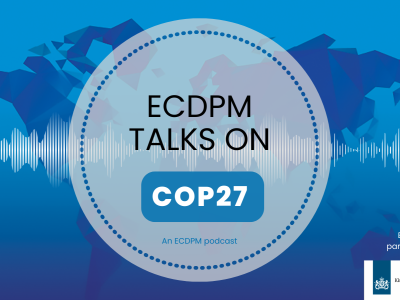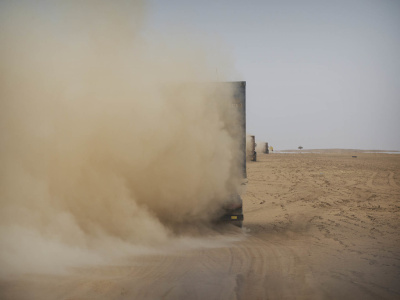
Peace and Security: The Head and Shoulders of EU-Africa Relationship
Peace and security is a key area of the relationship between Africa and the EU. Progress so far in defining an African-owned P&S architecture deserves to be highlighted though challenges remain.
There is little or no doubt that Peace and Security is one of the key areas in the co-operation between Africa and Europe. It could not be otherwise, having in mind the geographic closeness, the strong historical links and the web of mutual interests in fighting some of the nastier scourges of our times like terrorism or all kinds of traffics, from people to drugs, just to mention a few examples.
Still, common interests and proximity were not enough by themselves to achieve the type of effective collaboration corresponding to the size of the tasks. It was clear, and both sides understood it, that we needed to have a sound structural base to steer this co-operation in such a way that it could ensure its sustainability, predictability and effectiveness. The machinery, if I can use the word, is now in existence through different but complementary dimensions. It is not a closed process, far from it, but a few strands are already in place to help achieve the target.
The pivotal role of the African Peace and Security Architecture
The African Peace and Security Architecture (APSA) should be considered head and shoulders above the rest in my view. Why? Because it reflects a conscious effort from Africa to define its own destiny, provide its own tools, determine its own configuration, present solutions to address challenges. Furthermore, it understands that Peace and Security is hardly just a matter of military activities, rather it explores an inclusive approach that factors the need to tackle the root causes of conflict. Finally, because it sends a clear message to the international community about the priorities that Africa is privileging in this realm. It might not be perfect, it is surely evolving as we have seen with the announcement of CARIC, but is a fundamental step to let Africa exercise the African ownership Africa wants and merits.
Secondly, the existence on the European side of a mechanism which can provide continuous financial support in the guise of the African Peace Facility, allowing the partner Europe to stand by the partner Africa as much in operations (AMISOM, MICOPAX, AFISMA, etc.) as in long-term projects in areas like training or mediation that are essential to prepare the future.
The political willingness should not be overlooked, though. In the wider space of the Joint Africa-EU Strategy (JAES), Peace and Security is the first partnership and certainly not by chance, as I am sure the original drafters understood, perhaps even intuitively, its pivotal role in ensuring the conditions for all other areas to flourish. The JAES architecture tried to build several different layers of exchange, associating the then-created Informal Joint Expert Groups (iJEGs) to the work of the Joint Coordination Committee of the Africa Peace Facility, the dialogue between the Peace and Security Councils of the two sides and, up in the scale, the Ministerial meetings and of course, the annual meetings of the Commissions of the two Unions, not to mention at the very end of the pyramid the Summits where every three years in average the issues of Peace and Security receive the attention they deserve from the Heads of State or Government.
In parallel, a huge number of contacts are taking place with assiduous frequency between Europeans and Africans interested in Peace and Security. Be it Commissioners, Senior Officials, Middle Managers or just experts, at national or regional level, belonging to Member states or institutions, the number of face-to-face meetings, video- or tele-conferences or written contacts is too broad to detail here. Honestly, I even suspect that no one has actually a full and comprehensive list, although as you will notice below we make a strong attempt to circulate and treat information.
As it can be seen, we have thus political will, reasonably-working structures, financial and human resources, clear objectives. Is that enough? Is everything delivering properly? Is there room for improvement? I would offer two "nos" and a "yes" to these three questions. As I wrote above, we are speaking about a process more than about sacred and immutable "truths" that the dynamics of reality would surely prove wrong easily. Therefore, constant evaluations and revisions are naturally needed and welcome, while the thinking of independent voices, in Africa and Europe, is also playing a preeminent and healthy role in pointing out weaknesses and in suggesting how it can be done better or more accurately.
Meeting the remaining challenges
I would like to mention a few of what I (and surely not only me) perceive as current shortcomings. I will start with the issue of funding. EU and its member-states have been the main providers of financial support to the African-led Peace and Security Operations which is not only not sustainable for ever but is also detrimental to the implementation of the concept of African ownership. Africa and African countries could and should upgrade their support. The African Peace Fund, managed by the AU, has not really fulfilled its potential so far, it would be important to revitalise it and transform it in key instrument for the use of pooled resources. The AU contribution to AFISMA and the announced full responsibility for the first 30 days of operation of CARIC are encouraging signals that Africa thinking is very much on the same wavelength.
Then, we have the issue of absorption. African structures have been looking for building capabilities for years without achieving yet an optimal point. This causes considerable frustration amongst the international donors and certainly no less disenchantment amongst African people when allocated resources are not spent due to the impossibility of finding the right capacities to make projects a reality. By no means a problem restricted to Peace and Security but nevertheless a problem that needs a better and more balanced approach and a sensible evaluation about what is feasible and what is desirable but not immediately possible. In a nutshell, the levels of ambition should match the means at its disposal.
Institutional and working relations between AU and the Regional Economic Communities/Regional Mechanisms (RECs/RMs) have improved considerably in the last few years. The role of the Liaison Officers in Addis and in the capitals of the countries hosting the RECs/RMs - which the EU supports - has been instrumental in increasing mutual trust and provide deeper exchanges of information. Again, though, more work is necessary since differences of philosophy about the respective roles are lingering. As APSA is anchored by the umbilical cord linking the two camps, it is paramount that there will be clarity in this relationship, that each side will know exactly what are its tasks with no sign of ambiguity being present. I am certainly confident it will not take much longer to register progress in this particular area.
Another field where we could improve is maybe a little more theological but no less important. Our levels of co-operation, as mentioned before, are pretty good but sometimes one has the feeling we could still raise the bar to reach an environment that could translate in a stronger way the partnership enshrined in the framework document approved in the Lisbon Summit back in 2007 (the JAES). It is not that we are not doing it - the Amani Africa I and II exercise cycles are a good example about what we can achieve working hand in hand - only that we are not doing it as systematically as we could and, perhaps, should. Nevertheless, we try harder everyday to achieve this goal. A special reference should be made, in this context, to the first-rate work of the Peace and Security Sector of the EU Delegation to the Africa Union. Its role in advising, informing and coordinating input in Peace and Security matters from the international community present in the Ethiopian capital deserves to be publicly acknowledged.
In the last two years, I have been the European co-chair of the iJEG Peace and Security of the JAES. A stimulating experience that allowed me to have a better insight of the current challenges and those ahead of us. The group has the merit of trying to be a sort of a clearinghouse on the European side, focusing on identifying what the EU institutions and the EU Member States are currently doing in this domain and as such helping to define a more complete picture of what is happening in our corner of the co-operation with Africa. Naturally the information is provided on a volunteer basis and by those who choose to attend. The iJEG has been a layer of dialogue in between meetings at a higher level, an outlet for free-flow discussions (as it should be for a non-decision making body) where ideas can be tested and messages spread. It monitors the implementation of the Action Programme decided in the Summit and can produce suggestions to the Institutions. It has been a useful tool, albeit its importance should not be over-exaggerated. By that, I mean Peace and Security dialogue between Africa and EU can survive in many other guises and take advantage of other existing offers/spaces/fora to keep the good momentum flowing.
Conclusion
The EU will keep investing in Peace and Security as an essential condition for Africa to achieve prosperity. We know Africans share this opinion and are keen that we remain at their side as reliable partners. It is a success story, notwithstanding all the caveats that can be read above and whose role, in my modest view, serve as reminders that we shall not rest on any type of laurels, rather continuously adjusting to a moving reality. Crisis in Sahel, in the Horn, in the Great Lakes, to name a few, are there as grim evidence that it is not at all a matter closed.
José Costa Pereira is Head of the Pan-African Division of the European External Action Service (EEAS).
The opinions expressed in this article are those of the author and not necessarily of the institution he works for.
This article was published in GREAT Insights Volume 2, Issue 6 (September 2013).




